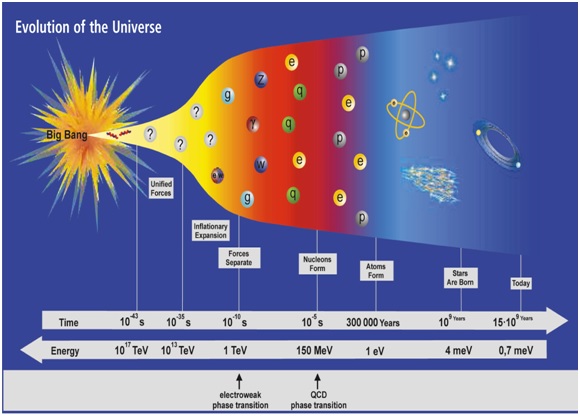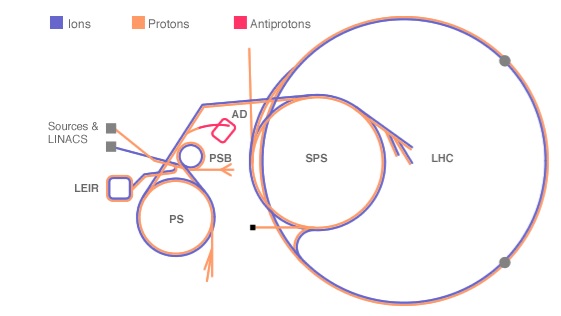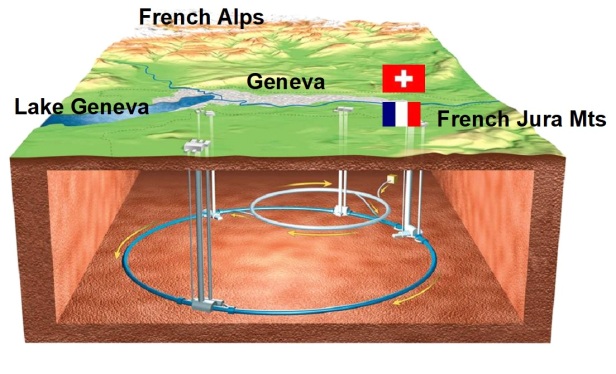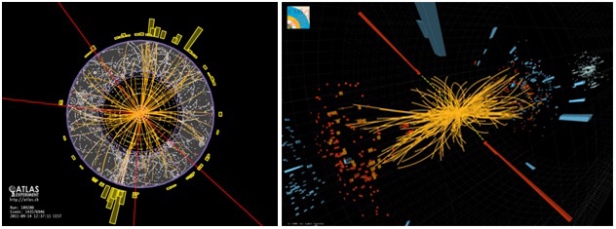What is the depth of Delhi or Kolkata metro-tunnels? The deepest one would be about 30 metres. We are talking about a tunnel of 27 km circumference and of 100 metre depth criss-crossing the borders of France and Switzerland. This tunnel is a part of the world’s largest accelerator laboratory, credited with several Nobel Prizes directly or indirectly and the birthplace of World Wide Web (WWW).
It was the time when World War-II was over but the smell of war was still in the air. There was almost no scope to talk of basic science but a group of scientists put their heads together and in 1951 decided to build a laboratory that now facilitates accelerating tiny particles to such an unprecedented velocity that when hit with it, particle-like proton breaks into elementary particles called quarks or partons. This particular laboratory known as European Centre for Nuclear Research (or in French Conseil Européen pour la Recherche Nucléaire or CERN) is now the world’s largest accelerator centre. Over the years, CERN has evolved from its first relatively small accelerator system to the present Large Hadron Collider (LHC) involving more than 10,000 scientists from all over the world, a prominent fraction of them are from India mainly involved in performing two of the four large experiments at CERN. The worldwide team work together to reach a scientific goal that can in a few words be expressed as “understanding of the origin of the universe”. India has contributed by building equipment which is being used in CERN accelerator and in the two experiments.
If we have a close look at the Fig.1 that describes the evolution of the universe from the Big-Bang till today, during the total expanse of this space-time diagram, the hot universe expands and cools down. In this diagram, two landmarks in this evolution are of main importance for science at LHC: one around the time when the temperature of the universe was around 5.5 trillion degree celsius (compare with 5000 degree celsius, the temperature of sun), and another region is about a thousand time cooler and a microsecond just after the Big-Bang.
At LHC, the first landmark is to create and discover a particle called Higgs Boson which is responsible for the mass of all the elementary particles. Particles that interact more with Higgs Bosons will have greater mass and those interacting less will have lesser mass just like a fish with streamline body interacts less with water while an elephant will interact more.
Boson is a class of particles that follow particular statistical rules as theorized by Indian scientist Prof. Satyendranath Bose. All pervading influence of Higgs Boson encompassed the universe after the Big bang and the strength of interaction with a particular elementary particle decides its respective mass. The discovery of Higgs Boson is a fundamental requirement in filling a major gap in understanding our Universe.
The other landmark for LHC science is somewhat later (at about micro-second old universe) in Fig.1, when the free quarks – a type of elementary particle and a fundamental constituent of matter, clubbed together (using gluons—an elementary particle that acts as the exchange particle for the strong force between quarks) to form particles like protons, neutrons and so on. Until then the universe is believed to have been in the form of an equilibrated soup of quarks and gluons, the fundamental constituents of protons and neutrons. This soup is called Quark Gluon Plasma similar to the plasma of electrons and ions that we see in electric arcs. Both these landmark events i.e., presence of Higgs boson and of Quark Gluon Plasma have strong theoretical bases and have been waiting for decades to be discovered and then to validate major cornerstones of fundamental theories.

CERN accelerator
Let’s now discuss the accelerators at CERN in somewhat detail. An accelerator makes use of magnetic and electric fields to accelerate charged particles moving either in a circular or a linear path. In a large accelerator facility like CERN, one first accelerates the particles to a relatively small velocity in one section of the accelerator before injecting into other sections for gaining higher energy. CERN today is a collection of a set of rings that helps particles to achieve a velocity close to that of the velocity of light (0.999997828c).
The largest ring of 27 Km circumference located 100 metre underground consists of a series of magnets and electric devices that keep the particles confined in a circular path while getting accelerated. The twin-ring of largest circumference called the Large Hadron Collider (LHC) allows particles circulating in opposite directions and to collide at four pre-defined locations. All these magnets operate at a temperature of -271 degree celsius. CERN thus has the distinction of being the coldest place on the earth. On the other hand, to avoid circulating particles not getting lost while colliding the remaining air particles inside the tunnel, the tunnel is kept at a level such that there is about a billion times less air pressure compared to the atmospheric pressure. CERN tunnel is thus also one of the emptiest places in the world.
LHC could be categorised as a type of accelerator called synchrotron that uses both magnetic and electric fields to accelerate and guide the particles in a circular path. Processes, commonly known as cooling is employed to constrain the particle energy and not to fluctuate significantly. A cooling method, known as stochastic cooling has been discovered at CERN by Prof. Van-der-Meer for which he was awarded the Nobel Prize in 1984, along with Prof. Carlo Rubia who received the prize for his contribution in discovering W and Z bosons, the communicators of weak interaction. This particular example shows the collaboration of accelerator scientist and particle physicist to achieve a major discovery. Present CERN as shown in Fig. 2 is a complex association of accelerator rings. Each of the circles is being used both in stand-alone and as injectors for higher energy rings. The particles that collide at LHC are of different types, from proton to lead ions.
Experiments at LHC
What do we do with these accelerating particles? We have two options, either bombard another stationary particle or collide with an oppositely moving particle. In both cases, dumped energy will then be converted into particles as per Einstein’s laws.
Let us now look at the debris from these collisions and study how on earth scientists can make use of them to understand nature. In some sense, it is a detective work in which the particles that come out of the debris need to be analysed to infer the type of system that is created. As we have seen in Fig. 1, there are mostly question marks below 10-20 second. In this artistic view, this implies that the evolution of the universe at the very initial stage is mostly unknown. The approach that is being followed at CERN is to create a system mimicking the early universe commonly known as mini-bang. Higher the energy of the collision closer we are to mimicking the Big Bang.

At CERN, where the larger part of the laboratory is underground, Millions of collisions are taking place every second and giant cameras are busy clicking pictures of each collision. The assembly of these complicated sets of cameras is known as Experiments. There are four major experiments at LHC i.e. ATLAS, CMS, LHCB and ALICE. Each experiment weighing from 2500 ton to 14000 ton is set up in such a way that they are tuned to catch signals of specific physics interest. For example, ATLAS and CMS are experts for the discovery of Higgs, ALICE is for Quark-gluon plasma and LHCB to understand the formation of particles. Each of these huge experiments is an engineering marvel using the latest technology so as to deal with the challenges of measurement of particles from the debris of collision.
Some of the specific challenges are to be able to detect in 10-12 sec, to measure momenta of more than 10000 particles from one collision. Interestingly, even with several commonalities, each of these four experiments has their own specific equipment to handle the signal that they want to catch. All these lead to the coming together of thousands of scientists from across the globe to understand the universe.

In general, the experimental sites are such that specially designed magnets are tuned precisely for the closely packed beam bunches to collide. The collision of each particle-pair could potentially be a source of a major discovery. It is therefore of utmost importance that all particles coming out of the collisions are measured in their full glory. This requires detectors covering the entire volume surrounding the collision zones. In practice, it is not possible for every experiment to be capable to detect every particle equally well, so specialized techniques are adopted keeping in focus a set of observables that might be the result as a combination of various measurements.
In the history of particle physics, if we look at very carefully, every 3 years there is a Nobel Prize that is a result of studies done using accelerator. In addition to this, starting from 1901 with the discoveries of X-rays till recent discovery of Higgs Boson at CERN, there are a large number of Nobel prize winning discoveries that could become possible only because of novel detectors and accelerators. CERN is a minefield of detector technologies, almost all possible types of detectors are built here starting from sub-micron to several metre size. The complexities in detection techniques and innovative detector materials lead us to be able to break the barriers of precise measurements that unravel all rare physics phenomena which would have otherwise remained hidden in nature.
CERN and technology
Before talking about two major discoveries at LHC, I would like to mention two specific areas that have seen tremendous advancement at CERN thanks to the advanced accelerator and detector technologies. The areas are Electronics and Computation. The challenges are two-fold: the small size and large number. Each of these miniature detector elements is to be read out separately to extract the signal from individual cells. Millions of signals are then to be clubbed together to recognise each collision. To combat these challenges, dense low-power electronic systems were developed that could survive the harsh radiation environment. At CERN, each of these experiments makes use of custom-built miniature circuits and put them together for a specific use.
On the other hand, billions of digitized information is to be stored and processed in a reasonable time. This leads to extreme use of information technology to deal with data that will be of the larger number that the total number of human words spoken so far! WWW was the result of the need for information-sharing among the collaborators of a large experiment in 1990s. The challenges with LHC data are two-fold, how to store the data and how to process them quickly. The method that is adopted at CERN is to make use of all computer firms all over the world by connecting them via a high-speed network. The technology that is being used for LHC data is commonly known as grid computing. It does not require a huge amount of computing resources at one place and make use of available resources all over the globe. Surely, this technology has its own issue of security, however, the world community has shown the usefulness of this technology by announcing the discovery of Higgs Boson within 2 years of first data taking at LHC. Two such centres dedicated for LHC computing are in India at VECC-Kolkata and TIFR-Mumbai.
India at CERN
The participation of India at CERN started in 1960s with the contribution of H.J. Bhabha followed by several other Indians participating in studies using beams from CERN accelerator. India as a country started participating around 1990 when the Department of Atomic Energy (DAE), Govt of India, had an agreement with CERN. The Department of Science and Technology (DST) followed soon and today it is a hugely successful collaboration between two major government departments that have been steering India’s participation at CERN. At LHC, in particular, India has contributed in building equipment like corrector magnets, high-precision jacks and participated in the characterisation of superconducting magnets. Apart from helping to build LHC, Indian researchers are involved in two major experiments i.e, CMS and ALICE. At present, more than 30 institutions have been participating to building detectors, electronics and actively participating in data analysis that leads to the discoveries. Major equipment built by India for these two experiments include Photon Multiplicity Detector (PMD), a high granularity gaseous proportional chamber aimed to measure the spatial distribution of photons in ALICE around the direction of beam particles, muon chamber: a large cathode chamber for muon tracking in ALICE located in a direction opposite to that of PMD, Calorimeter modules for the CMS experiment and electronics, Resistive Plate Chamber (RPC) and Gas Electron Multiplier (GEM), both for the CMS experiment. India, as mentioned above is a major contributor in the grid computing infrastructure of LHC data analysis. Fig. 4 shows snapshots of some such activities.

Fig.4: (left) Production of quench power supply for CERN at Electronic Corporation of
India Ltd (ECIL)-Hyderabad, India; (right) Indian collaborators with the Photon Multiplicity
Detector (PMD) as a part of the ALICE experiment at CERN
Conclusion
I would like to conclude with two major scientific discoveries from CERN very recently, one is the discovery of Higgs particles that is responsible for the creation of a mass of elementary particles and the other is of the Quark-gluon plasma that represents the state of the micro-second old universe. The discovery of Higgs that was elusive for so long to the scientists brought the Nobel Prize of the year 2013 to Prof. Peter Higgs and Prof. Francois Englert, two proponents of the theory that required such a particle to explain the mass of the particles. Fig. 5 shows snapshots of collisions containing Higgs boson decaying into different particles.

Fig. 5: Snapshot of collisions containing Higgs boson
A huge collaboration of science, technology and humanity at LHC-CERN not only unravels the mystery of the universe but also go deeper into an International co-operation of which India is a proud partner. Finally, CERN is a microcosm of human collaborators, CERN cafeteria serves food that suites the plates of all countries in the world. It is CERN which is a true world laboratory and the presence of India is highly prominent. Two especially made pavillions are showcasing both CERN and Indian participation at CERN in the ongoing mega science exhibition in the Nehru Science Centre, Mumbai that is to travel to Bangalore, Kolkata and Delhi subsequently.
